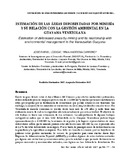Estimación de las áreas deforestadas por minería y su relación con la gestión ambiental en la Guayana Venezolana
Fecha
2017Palabras Clave
Arco Minero del Orinoco, Impacto ambiental, Conservación, Escudo GuayanésOrinoco Mining Arc, Environmental impact, Conservation, Guayana Shield
Metadatos
Mostrar el registro completo del ítemResumen
Existe un gran debate sobre el Arco Minero del Orinoco y sus efectos ambientales potenciales; el área declarada para ese megaproyecto es casi de 112.000 km2 y muchas personas e instituciones están preocupadas por la destrucción de ecosistemas que podría ocurrir en ese territorio. Sin embargo, la mayoría de los minerales se encuentran en sitios muy localizados con alto tenor. En Venezuela la minería comercial se ejecuta desde hace más de 170 años y nadie tiene una evaluación exacta de cuál es la superficie afectada actualmente por esta actividad. El objetivo de este trabajo es hacer una estimación de esa extensión. La interpretación de algunos trabajos cartográficos indica que el área total deforestada en la Guayana Venezolana pudiera llegar aproximadamente a 6.300.000 ha; la revisión de reportes y de lugares representativos de áreas deforestadas señala que la minería pudiera estar afectando unas 200.000 ha; eso representa sólo el 3,2 % del total deforestado en la región. Por lo tanto, la principal causa de deforestación son la ganadería y la agricultura anárquicas. Eso debe ser tomado en cuenta por los hacedores de políticas sobre gestión ambiental. Se conoce de propuestas para crear nuevas Áreas Bajo Régimen de Administración Especial (ABRAE) y cambiar algunos de estos ámbitos naturales por figuras más restrictivas y conservacionistas; pero la realidad es que ya existe destrucción en parques nacionales y monumentos naturales; esas figuras no han detenido la devastación. No hacen falta nuevas ABRAE´s en el papel, lo que debe ocurrir es que el Estado cumpla con lo que ya existe.
Información Adicional
| Otros Títulos | Estimation of deforested areas by mining and its relationship with environmental management in the Venezuelan Guayana |
| Correo Electrónico | jolozada@ula.ve |
| Editor | SaberULA |
| ISSN | 0556-6606 |
| Resumen en otro Idioma | There is a great debate about the Orinoco Mining Arc and its potential environmental effects; the area declared for this megaproject is almost 112,000 km2 and many people and institutions are concerned about the destruction of ecosystems that could occur. However, most minerals are found in highly localized sites with high content; in Venezuela, commercial mining has been carried out for more than 170 years and no one has an exact assessment of which surface is currently affected by mining. The objective of this paper is to estimate this extension. The interpretation of some cartographic works indicates that the total area deforested in the Venezuelan Guayana could reach 6,300,000 ha; the review of reports and representative places of deforested areas indicates that mining could be affecting some 200,000 ha; that represents only 3,2 % of the total deforested in the region. Therefore, the main cause of deforestation are anarchic cattle ranching and agriculture. That must be taken into account for environmental management policies. There are proposals to create new areas under special administration regime (SAR) and change some for more restrictive and conservationist figures; but the reality is that there is already destruction in national parks and natural monuments; those figures have not stopped the devastation. There is no need for new SAR in paper, what must happen is that whole nation complies with what already exists. |
| Colación | 59-77 |
| Periodicidad | Semestral |
| País | Venezuela |
| Institución | Universidad de Los Andes |
| Publicación Electrónica | Revista Forestal Venezolana |
| Sección | Revista Forestal Venezolana: Artículo |






